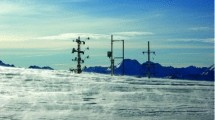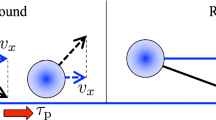Abstract
Snowdrift is one of the manymanifestations of two-phase flow, in which theinteraction between suspended particles and theambient fluid brings about some interesting features.Specifically, the drag required to keep particles insuspension against the downward gravitational pullrequires expenditure of turbulent kinetic energy(TKE). Other effects include the increased density of theair-snow mixture and the stable thermal stratificationcaused by the snowdrift sublimation-induced cooling.An atmospheric surface-layer model that includes snowdriftsuspension is described that includes the effects ofupward diffusion, gravitational settling andsublimation of snow particles in 48 size classes, theeffects of snowdrift sublimation on the heat andmoisture budget of the surface layer and the dampingof turbulence in the presence of suspended particles. Thewell-known E-ε closure model is applied toevaluate the eddy exchange coefficient, with a newterm representing buoyancy reduction induced by thestably stratified suspended particle profile includedin the prognostic equation for TKE.
Similar content being viewed by others
References
Adams, C. E., Jr. and Weatherly, G. L.: 1981, ‘Some Effects of Suspended Sediment Stratification on an Oceanic Bottom Boundary Layer’, J. Geophys. Res. 86, 4161–4172.
Bagnold, R. A.: 1941, The Physics of Blown Sand and Desert Dunes, Methuen, London, 265 pp.
Bagnold, R. A.: 1966, ‘An Approach to the Sediment Transport Problem from General Physics’, U. S. Geol. Surv. Prof. Pap. 422-I, 37 pp.
Bintanja, R.: 1998a, ‘The Interaction between Drifting Snow and Atmospheric Turbulence’, Ann. Glaciol. 26, 167–173.
Bintanja, R.: 1998b, ‘The Contribution of Snowdrift Sublimation to the Surface Mass Balance of Antarctica. Ann. Glaciol. 27, 251–259.
Bintanja, R.: 2000, ‘Snowdrift Suspension and Atmospheric Turbulence. Part II: Results of Model Simulations’, Boundary-Layer Meteorol 95, 391–417.
Bintanja, R. and van den Broeke, M. R.: 1995, ‘Momentum and Scalar Transfer Coefficients over Smooth Antarctic Surfaces’, Boundary-Layer Meteorol. 74, 89–111.
Bridge, J. S. and Dominic, D. F.: 1984, ‘Bed Load Grain Velocities and Sediment Transport Rates’, Water Resour. Res. 20, 476–490.
Budd, W. F.: 1966, ‘The Drifting of Nonuniform Snow Particles’, in M. Rubin (ed.), Studies in Antarctic Meteorology, AGU, Ant. Res. Ser. 9, 59–70.
Budd, W. F., Dingle, R., and Radok, U.: 1966, ‘The Byrd Snow Drift Project: Outline and Basic Results’, in M. Rubin (ed.), Studies in Antarctic Meteorology, AGU, Ant. Res. Ser. 9, 71–134.
Carrier, C. F.: 1953, ‘On Slow Viscous Flow, Final Report’, Brown University, Providence, Office of Naval Research Control Nonr–653–00/1.
Chamberlain, A. C.: 1983, ‘Roughness Length of Sea, Sand and Snow’, Boundary-Layer Meteorol. 25, 405–409.
Clift, R., Grace, J. R., and Weber, M. E.: 1978, Bubbles, Drops and Particles, Academic Press, New York, 380 pp.
Déry, S. J. and Taylor, P. A.: 1996, ‘Some Aspects of the Interaction of Blowing Snow with the Atmospheric Boundary Layer’, Hydrol. Proc. 10, 1345–1358.
Déry, S. J., Taylor, P. A., and Xiao, J.: 1998, ‘The Thermodynamic Effects of Sublimating Snow in the Atmospheric Boundary Layer’, Boundary-Layer Meteorol. 89, 251–283.
Detering, H. W. and Etling, D.: 1985, ‘Application of the E-∈ Turbulence Model to the Atmospheric Boundary Layer’, Boundary-Layer Meteorol. 33, 113–133.
Dover, S. E.: 1993, ‘Numerical Modelling of Blowing Snow’, Ph.D. Thesis, University of Leeds, 223 pp.
Duynkerke, P. G.: 1988, ‘Application of the E-∈ Turbulence Closure Model to the Neutral and Stable Atmospheric Boundary Layer’, J. Atmos. Sci. 45, 865–880.
Duynkerke, P. G. and Nieuwstadt, F. T. M.: 1989,'A Solution of the E-∈ Model for Nearly Homogeneous Turbulence with a Mean Shear’, Appl. Sci. Res. 46, 25–43.
Gallée, H.: 1998, ‘Simulation of Blowing Snow over the Antarctic Ice Sheet’, Ann. Glaciol. 26, 203–206.
Gallée, H., Guymarc'h, G., and Brun, E.: 1999, ‘Impact of Snowdrift on the Antarctic Ice Sheet Surface Mass Balance: A Sensitivity Study to Snow Surface Properties’, Boundary-Layer Meteorol., submitted.
Garratt, J. R.: 1992, The Atmospheric Boundary Layer, Cambridge University Press, Cambridge, 316 pp.
Gosink, J.: 1989, ‘The Extension of a Density Current Model of Katabatic Winds to Include the Effects of Blowing Snow and Sublimation’, Boundary-Layer Meteorol. 49, 367–394.
Hino, M.: 1963, ‘Turbulent Flow with Suspended Particles’, J. Hydraul. Div. Am. Soc. Civ. Eng. 89 (HY4), 161–185.
Hunt, J. N.: 1969, ‘On the Turbulent Transport of a Heterogeneous Sediment’, Quart. J. Mech. Appl. Math. 22, 235–246.
Hunt, J. C. R. and Nalpanis, P.: 1985, ‘Saltating and Suspended Particles over Flat and Sloping Surfaces’, in O. E. Barndorff-Nielsen et al. (eds), Proc. International Workshop on the Physics of Blown Sand, University of Aarhus, pp. 9–35.
Kikuchi, T.: 1981, ‘A Wind Tunnel Study of the Aerodynamic Roughness Associated with Drifting Snow’, Cold Regions Sci. Technol. 5, 107–118.
Kind, R. J.: 1986, ‘Snowdrifting: A Review of Modelling Methods’, Cold Regions Sci. Technol. 12, 217–228.
King, J. C., Anderson, P. S., Smith, M. C., and Mobbs, S. D.: 1996, ‘The Surface Energy and Mass Balance at Halley, Antarctica during Winter’, J. Geophys. Res. 101, 19119–19128.
Kodama, Y., Wendler, G., and Gosink, J.: 1985, ‘The Effect of Blowing Snow on Katabatic Winds in Antarctica’, Ann. Glaciol. 6, 59–62.
Lee, L. W.: 1975, ‘Sublimation of Snow in Turbulent Atmosphere’, Ph.D. Thesis, University of Wyoming, 162 pp.
Leeder, M. R.: 1983, ‘On the Dynamics of Sediment Suspension by Residual Reynolds Stresses – Confirmation of Bagnold's Theory’, Sedimentology 30, 485–491.
Li, L. and Pomeroy, J. W.: 1997, ‘Estimates of Threshold Wind Speeds for Blowing Snow Using Meteorological Data’, J. Appl. Meteorol. 36, 205–213.
Lumley, J. L.: 1978, ‘Two-Phase and Non-Newtonian Flows’, in P. Bradshaw (ed.), Topics in Applied Physics, Vol. 12, Springer, New York, pp. 289–324.
Maeno, N., Araoka, K., Nishimura, K., and Kaneda, Y.: 1979, ‘Physical Aspects of the Wind-Snow Interaction in Blowing Snow’, J. Fac. Sci. Hokkaido Univ., Ser. 7, 6, 127–141.
Maeno, N., Nishimura, K., and Kaneda, Y.: 1980, ‘Viscosity and Heat Transfer in fluidized Snow’, J. Glaciol. 26, 263–274.
Mann, G. W.: 1998, ‘Surface Heat and Water Vapour Budgets over Antarctica’, Ph.D. Thesis, University of Leeds, 279 pp.
McKenna Neuman, C. and Nickling, W. G.: 1994, ‘Momentum Extraction with Saltation: Implications for Experimental Evaluation of Wind Profile Parameters’, Boundary-Layer Meteorol. 68, 35–50.
Nalpanis, P., Hunt, J. C. R., and Barrett, C. F.: 1993, ‘Saltating Particles over Flat Beds’, J. Fluid Mech. 251, 661–685.
Nishimura, K., Sugiura, K., Nemoto, M., and Maeno, N.: 1998, ‘Measurements and Numerical Simulations of Snow Particle Saltation’, Ann. Glaciol. 26, 184–190.
Owen, P. R.: 1964, ‘Saltation of Uniform Grains in Air’, J. Fluid. Mech. 20, 225–242.
Panofsky, H. A. and Dutton, J. A.: 1984, Atmospheric Turbulence: Models and Methods for Engineering Applications, Wiley, New York, 397 pp.
Pomeroy, J. W. and Gray, D. M.: 1990, ‘Saltation of Snow’, Water Resour. Res. 26, 1583–1594.
Pomeroy, J. W. and Gray, D. M.: 1994, ‘Sensitivity of Snow Relocation and Sublimation to Climate and Surface Vegetation’, in Jones, H. G. et al. (eds.), Snow and Ice Covers: Interactions with the Atmosphere and Ecosystems. IAHS Publ. No. 223, pp. 213–225.
Pomeroy, J.W. and Male, D. H.: 1992, ‘Steady-State Suspension of Snow’, J. Hydrol. 136, 275–301.
Pomeroy, J. W., Gray, D. M., and Landine, P. G.: 1993, ‘The Prairie Blowing Snow Model: Characteristics, Validation, Operation’, J. Hydrol. 144, 165–192.
Pruppacher, H. R. and Klett, J. D.: 1978, Microphysics of Clouds and Precipitation, Reidel Publ. Company, Dordrecht, 713 pp.
Radok, U.: 1970, ‘Boundary Processes of Drifting Snow’, in Studies on Drifting Snow, Meteorology Department, University of Melbourne, Publ. No. 13, Melbourne, 20 pp.
Rouault, R. R., Mestayer, P. G., and Schiestel, R.: 1991, ‘A Model of Evaporating Spray Droplet Dispersion’, J. Geophys. Res. 96(C4), 7181–7200.
Schmidt, R. A.: 1980, ‘Threshold Wind-Speeds and Elastic Impact in Snow Transport’, J. Glaciol. 26, 453–467.
Schmidt, R. A.: 1982a, ‘Properties of Blowing Snow’, Rev. Geophys. Space Phys. 20, 39–44.
Schmidt, R. A.: 1982b, ‘Vertical Profiles of Wind Speed, Snow Concentration, and Humidity in Blowing Snow’, Boundary-Layer Meteorol. 23, 223–246.
Schmidt, R. A.: 1986, ‘Transport Rate of Drifting Snow and the Mean Wind Speed Profile’, Boundary-Layer Meteorol. 34, 213–241.
Schmidt, D. S., Dent, J. D., and Schmidt, R. A.: 1998, ‘Charge-to-Mass Ratio of Individual Blowingsnow Particles’, Ann. Glaciol. 26, 207–211.
Shiotani, M. and Arai, H.: 1967, ‘On the Vertical Distribution of Blowing Snow’, in H. Oura (ed.), Physics of Snow and Ice, Hokkaido University, Saporro, Institute of Low Temperature Science, pp. 1075–1083.
Smith, M. C.: 1995, ‘The Role of Atmospheric Processes in the Antarctic Ice Mass Balance’, Ph.D. Thesis, University of Leeds, 220 pp.
Smith, J. D. and McLean, S. R.: 1977, ‘Boundary Layer Adjustments to Bottom Topography and Suspended Sediment’, in J. Nihoul (ed.), Bottom Turbulence, Elsevier, New York, pp. 123–151.
Sommerfield, R. and Businger, J.: 1965, ‘The Density Profile of Blown Snow’, J. Geophys. Res. 70, 3303–3306.
Takahashi, S., Naruse, R., Masayoshi, N., and Mae, S.: 1988, ‘A Bare Ice Field in East Queen Maud Land, Antarctica, Caused by Horizontal Divergence of Drifting Snow’, Ann. Glaciol. 11, 156–160.
Taylor, P. A. and Dyer, K. R.: 1977, ‘Theoretical Models of Flow near the Bed and their Implications for Sediment Transport’, in E. D. Goldberg (ed.), The Sea, Vol. 6,Wiley-Interscience, New York, pp. 579–601.
Thorpe, A. D. and Mason, B. J.: 1966, ‘The Evaporation of Ice Spheres and Ice Crystals’, Brit. J. Appl. Phys. 17, 541–548.
Ungar, J. E. and Haff, P. K.: 1987, ‘Steady State Saltation in Air’, Sedimentology 34, 289–299.
Wamser, C. and Lykossov, V. N.: 1995, ‘On the Friction Velocity during Blowing Snow’, Contr. Atmos. Phys. 68, 85–94.
Yalin, M. S.: 1972: Mechanics of Sediment Transport, Pergamon, New York, 290 pp.
Author information
Authors and Affiliations
Rights and permissions
About this article
Cite this article
Bintanja, R. Snowdrift suspension and atmospheric turbulence. Part I: Theoretical background and model description. Boundary-Layer Meteorology 95, 343–368 (2000). https://doi.org/10.1023/A:1002676804487
Issue Date:
DOI: https://doi.org/10.1023/A:1002676804487




